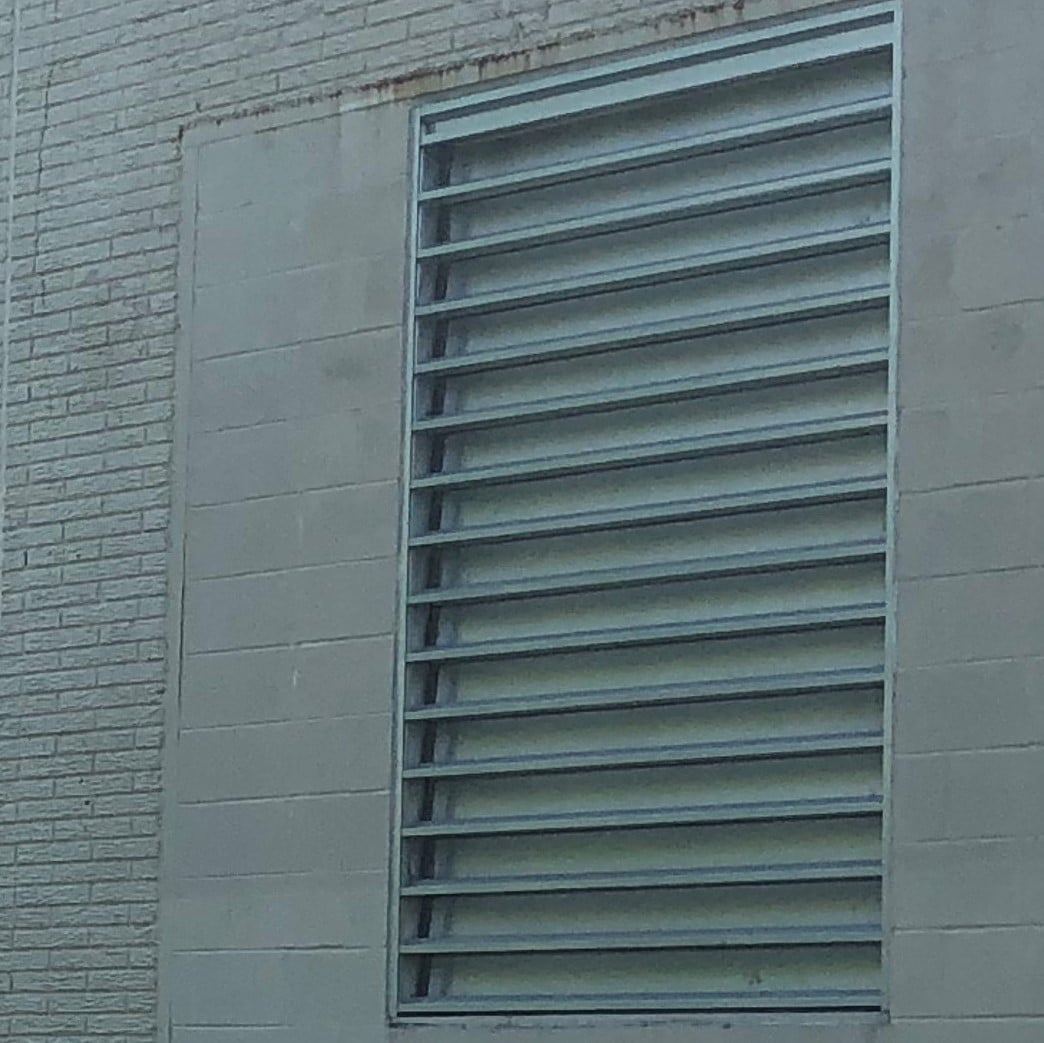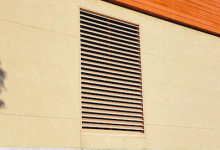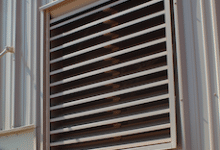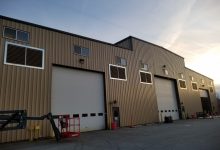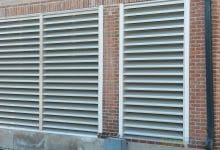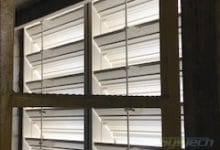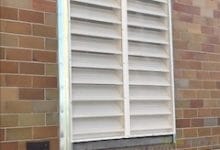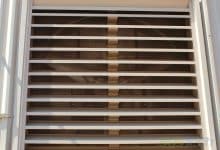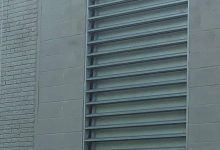Industrial Louvers
Industrial louvers have many names with most defined by their purpose or operation. They include Industrial wall louvers, fresh air intake louvers, air intake louvers, ventilation louvers, fixed or adjustable louvers, manual or motorized louvers, and exhaust louvers. Louvers used for ventilation purposes are constructed of various metals and plastics, with fiberglass packing internals if needed, determined by their environment.
We categorize louvers into three types: metal, fiberglass (FRP), and acoustic. Metal louvers are used in applications that are exposed to weather conditions of rain and snow, FRP for demanding corrosive environments, and acoustic for noise mitigation applications. In many instances, these are readily available as in-stock items or custom designs with short lead times.
Industrial Metal Louvers
Metal louvers are used in a multitude of industrial applications, but primarily in supply/exhaust ventilation systems. Louver designs vary by blade type, blade angle, and percentage of the free area required for the application. Blade depth is typically 6 inches, but dependent upon design considerations can be customized up to 8+ inches. Typical add-on options include bird screen, fasteners, and application-specific paints. Wall opening sizing that can be covered is unlimited, as individual louvers can be coupled and assembled into complete wall structures.
Types of Metal Louvers
Weather Louvers:
Drainable and non-drainable designs are available to optimize airflows for louvers expected to be exposed to rain and snow. Drainable blades contain gutters that drain water to the end of the blade and are typically used in locations where heavy rain is common. In contrast, non-drainable blades permit rain to fall directly off the blade into the incoming air path.
Extruded aluminum with stationary blades:
- Blade depths up to 6 inches
- Horizontal or vertical blades
- The minimum size of 12” x 12” and maximum size of 96” x 96”
- Drainable or non-drainable blades
Galvanized steel with stationary blades:
- Blade depths up to 6 inches
- Horizontal blade only
- The minimum size of 12” x 12” and maximum size of 96” x 96”
- Drainable or non-drainable blades
Extruded aluminum with adjustable blades:
- Blade depths up to 6 inches
- Horizontal blade only
- The minimum size of 12” x 12” and maximum size 60” x 96”
Galvanized steel with adjustable blades:
- Blade depth up to 6 inches
- Horizontal blade only
- Minimum size 12” x 12” and maximum size 60” x 96”
Extreme Weather Louvers:
Extreme weather louvers are intended to endure the harshest environmental factors, such as hurricanes. In locations where extreme whether considerations must be made, drainable louvers are typically used. These louvers are composed of galvanized steel or aluminum, making them extremely durable.
- Miami-Dade Rated
- Blade depth up to 8 inches
- Horizontal and vertical blades
- Min size 12” x 12” and max size 96” x 96”
Penthouse Louvers:
Penthouse louvers are constructed to protect rooftop air intakes and exhaust vents. The reinforced aluminum construction allows rooftop louvers to be durable and strong in harsh environmental conditions such as windstorms.
- Blade depth up to 8 inches
- Horizontal and vertical blades
- Min size 12” x 12” x 12” and max size 72” x 72”
- Drainable and non-drainable designs
How to Select a Louver
Louver selection is based upon weather conditions, airstream chemistry, and allowable pressure drop. Louver manufacturers publish performance information based upon AMCA test results for rain penetration, free area, and pressure drop through the louver. The following are key performance parameters of a louver to be considered when choosing the appropriate size and performance to meet your needs:
- Pressure Drop: Velocity through the louver determines pressure drop and pressure drop determines the fan horsepower required.
- Water Penetration: This is the maximum allowable velocity threshold where water can begin to penetrate a louver, determined through AMCA testing procedures.
- Free Area: The area of the louver that is not obstructed by the blades and frame. The free area determines velocity through the louver, water penetration, and pressure drop. If there is adequate wall space, this variable is the easiest to adjust.
Fiberglass (FRP) Louvers
Industrial louvers constructed of fiberglass are necessary where corrosive environments are prevalent in facilities such as wastewater treatment or processing plants where aggressive chemicals are common. All components of FRP louvers are constructed with fiberglass and isophthalic polyester resin, making them resistant to aggressive chemicals and allowing them to carry a Class I flame spread rating of 25 or less. All joints are mended with industrial-grade epoxy which has comparable corrosion resistance properties to polyester resin. Not only does this specialized construction allow for a lighter product than aluminum, but it also provides a 43% greater strength-to-weight ratio than aluminum. FRP applications that exceed maximum size can be custom designed with multiple panels reinforced construction. FRP louver designs suitable up to 200⁰ F are listed below:
Fixed blade drainable louver:
- Designed for free air inlet velocity of 825 FPM
- Minimum size 12” x 12” and maximum size 72” x 72” but multiple panel construction will allow for much larger size assemblies
End-pivoted automatic shutter:
- Designed for free air inlet velocity of 2,500 FPM
- Min size 12” x 12” and max size 48” x 48” but multiple panel construction will allow for much larger size assemblies
Fiberglass louver add-on options include:
- Hi-Cor construction with an abrasive/erosive resistant coating for surface exposed to the airstream
- Electrostatic grounding
- FRP bird screen
- FRP mounting angle
- Inlet and outlet guards
- Manual operators & locking quadrants
- Motor operator & actuators
Acoustic Louvers
Acoustic louvers are designed for noise mitigation from large building ventilation projects where operating machinery creates objectionable noise levels outside the facility. They are fabricated of aluminum or galvanized steel in 6, 8, or 12-inch depths and are all non-drainable design. Acoustic louvers have an outside top layer of metal, a bottom perforated metal sheet, and a sound absorbent core, which is fire and water-resistant.
- Blade depth up to 12”
- Flat or airfoil blades
- Min size 12” x 15” and Max size 72” x 96”
- Non-drainable
SysTech offers louvers suited to a variety of industrial duty air control applications, all engineered for optimal performance and efficiency. Let us help with your louver ventilation layout and design.

